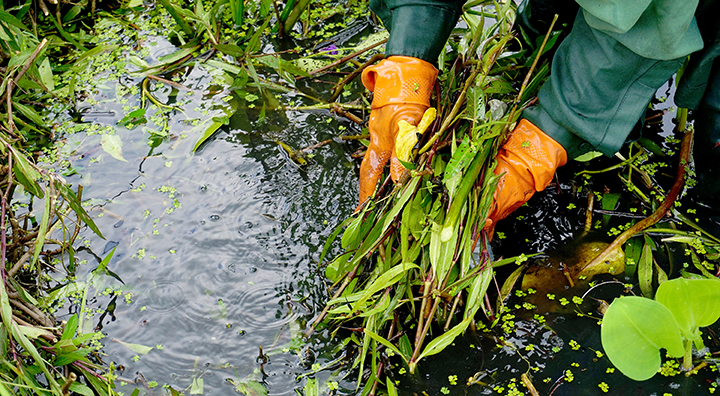
Regular pond maintenance ensures that your pond’s ecosystem stays healthy all year round and, as the season changes, so do the steps for keeping your pond in top condition.
As we move into autumn, the following tips will ensure that your pond is well equipped to handle the colder winter months ahead.
General check-up
With a lower water level and less wildlife inhabiting your pond, autumn is an excellent time to perform a pond health check. Carry out a partial water change (no more than 25%) and inspect each piece of equipment for wear and damage, including the pumps, filters, lights and all the cables, tubing and connections – even the pond liner. We would also recommend using a disease-preventative water treatment to keep pathogens in check over the colder months so that, come spring, your pond ecosystem is fighting fit.
Don’t let leaves build-up
Fallen autumn leaves may look beautiful – but you don’t want them to accumulate in your pond. As leaves break down in the water and begin to rot, the chemicals that are released can throw off the pond’s natural balance and wreak havoc with its health. While pond filters can help with leaves, the sheer volume dropped in autumn may lead to clogging. Regularly skimming the pond with a net will prevent filters from becoming overwhelmed and a pond vacuum cleaner can vacuum up the debris that has sunk to the bottom.
Another option is to lay a pond cover net over the pond’s surface to capture the bulk of leaf fall and make leaf disposal easy.
Keep everything trim and tidy
As well as preventing external leaf litter from piling up, it’s a good idea to monitor the plants within your pond as they begin to die back over the autumn months. Pruning back excess growth and dead or dying leaves reduces the amount of decaying vegetation. This is especially important in smaller ponds where a build-up is far more frequent.
If your pond is surrounded by evergreen trees, a bit of pruning can also help your water plants receive sufficient sunlight throughout the shorter days. This ensures that they remain healthy and strong – continuing to photosynthesise and replenish oxygen levels in the water.
Reduce fish feed
For those with fish in your ponds, your instinct might be to fatten them up to help them through the colder winter period. However, as temperatures drop, so does a fish’s metabolism, and with it their need for food. Feedings should be reduced to several times a week and the volume of food should be only what the fish can consume within a couple of minutes, as uneaten food can contaminate the water and lead to disease.
Fish are also at a higher risk of becoming food themselves during the winter months as prey becomes increasingly scarce. While pond cover nets are a good solution for falling leaves, they can serve the dual purpose of protecting your pond’s inhabitants from hungry predators.
When it comes to pond maintenance, a little can go a long way, and checking in on your pond at regular intervals throughout autumn will help you stay on top of any small issues before they can develop into large problems. This leaves you to enjoy your beautiful, healthy pond and appreciate the changes it undergoes as the season progresses.
